Top 12 Most Fearless Animals in the World: Hundreds of millions of animal species have evolved to exist in a variety of settings on the planet. The natural and biological environment that offered food, housing, and protection to the species is known as habitat. Terrestrial and aquatic habitats are the two main types of habitats. Terrestrial animals are those that rely on the land for their life, whereas aquatic animals are those that dwell in the water. Amphibians are creatures that can live on both land and water and are classified as such.
Terrestrial animals come in a variety of sizes and like to stay in their natural habitat; some are big herbivorous creatures that consume trees, grasses, and fruits, while others are carnivorous and devour the meat, bones, and blood of other animals.
Because of their enormous size and devastating power, certain animals are strong and fearless, while others have a ferocious reputation for maintaining their ground even when confronted by an animal much larger than themselves. Finding the bravest creature among the world’s numerous terrifying and remarkable species is a difficult challenge. Although some of these creatures may surprise you, they are all incredibly violent and will not back down from a battle.
Recommended: Countries with the most beautiful women in the world 2022
Top 12 Toughest and Most Fearless Animals on Earth
1. Honey badger: The Honey Badger is the world’s most brave terrestrial mammal. Just don’t judge them by their size; they’re more than capable of taking on a pack of lions much larger than themselves. Few predators dare to take on a honey badger because of their carnivorous nature, thick skin coated in fur, and great defensive qualities. Honey badgers’ skin is around 6mm thick, and their loose skin allows them to twist and spin quickly. Snake venom, such as that of the king cobra or Russell’s viper, is ineffective against them.
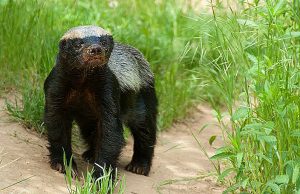
They have a tiny height, measuring approximately 30 inches in length and possessing short legs with five huge claws in the forelegs and short tails in the hindlegs, weighing around 12 kilograms. They are lonely creatures who prefer to live in burrows, which they dig with their formidable claws. Honey badgers, as its name implies, eat honey as their primary source of nutrition, and they will assault beehives in order to obtain it.
They get a lot of bee bites in the process, but it doesn’t seem to bother them because their thick skin protects them. Honey badgers are known for their street smarts and ability to outsmart other animals. Never one to back down from a battle, these tenacious little creatures have been known to shred the heads of venomous snakes and are immune to porcupine quills’ sharp spikes.
Also see: Best Countries to Study and work as a doctor
2. The Cape Buffalo: The Cape Buffalo, commonly known as the “Black Death,” is one of the most lethal creatures. They are herbivores, but their temperaments are brief and unpredictable. Due to their nasty reputation, they have never been tamed. Male cape buffalos are substantially larger and heavier than females, weighing in at over 1000 kg.
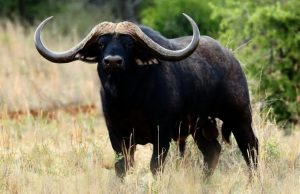
Their standing height is small, and their legs are short and thick. Male buffalos have strong horns that protrude upwards in a smooth curve over the base of their forehead, forming a shield. Open grasslands, wetlands, floodplains, and locations with long, tall grasses are their preferred habitats. They are grazers who need to drink every day; thus, they visit the water hole once or twice a day. There are no predators for an adult male buffalo.
They are better capable of defending themselves from an apex predator attack. To bring down an adult buffalo, a troop of lions is required, and lions can suffer life-threatening injuries as a result. Crocodiles like to prey on calves and young bulls and avoid mature bulls. Every year, more than 200 individuals are killed by Cape buffalos, who either stomp them or crush them with their terrifying horns. It takes ten years for the horns and bosses of the skull to fully develop. They are brave creatures, and their unpredictable and violent temperament distinguishes them as one of the most fearless.
Recommended: Advantages and Disadvantages of Working From Home
3. Hippopotamus: The hippopotamus is a big herbivorous, semi-aquatic, hairless mammal that may weigh up to 1500 kg. Some guys have been discovered to weigh between 3500 and 4000 kg. Male hippos continue to develop for the rest of their lives. They have strong muscular bones and jaws that expand broadly. They have the longest canine teeth in the animal kingdom, reaching 50cm, however, they don’t eat with them and only utilize them in battle. Hippos have a two-and-a-half-inch thick skin that protects them from predators.
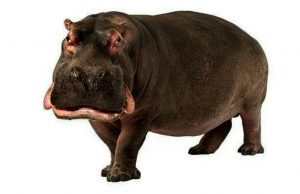
To protect themselves against disease-causing microorganisms, their skin secretes a natural sunscreen. They favor rivers, swamps, and mangroves as their environment since their lack of hair renders their skin sensitive to the elements and necessitates the use of water to regulate their body temperature. They are on the water for 16 hours every day. Hippos have previously attacked humans, and their unpredictable and violent character makes them one of the most fearless creatures.
When confronted, they do not hesitate to fight any animal and defend their territory. Males are more violent than females, and they are fiercely protective of their area, refusing to allow invasion.
Recommended: Advantages and Disadvantages of weeds to man
4. Komodo Dragon: The Komodo dragon is the world’s biggest reptile, at 10 feet tall and weighing up to 70 kg. They are one of the most fearless creatures due to their big size and ferocious reputation. Their tails are long and strong. Their bodies are covered with thick armored scales and feature formidable claws. Due to the presence of many poisonous proteins and septic bacteria, they have venomous bites, and a single bite is enough to immobilize their victim.
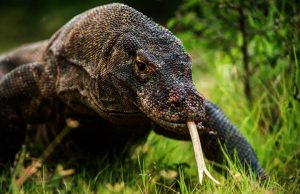
Komodo dragons enjoy savannahs, grasslands, and tropical forests because they are dry and hot. They are carnivorous, have poor hearing and night vision, and live for roughly 30 years. They use their forked tongue to obtain information about their environment and can detect prey from a distance of 9 kilometers.
They use a sneaky technique to ambush live victims and strive to kill them all. With their enormous tail, they can kill large pigs and deer in seconds. They can devour 80 percent of their body weight in one sitting, but their digestive metabolism is sluggish, so they lie down in the sun to speed it up.
Also see: Advantages and Disadvantages of being a woman
5. Nile Crocodile: The Nile crocodile is the world’s biggest reptile, growing up to 21 feet long. Females have a lesser stature than males. Depending on the region and environment, males can weigh up to 1200 kg. These crocodiles have a broad range of habitats and are opportunistic predators who like river deltas and mangrove swamps. They are regarded as one of the biggest and most ferocious of all crocodiles. They immerse themselves underwater and discreetly approach their target, then pounce with the most powerful biting force.
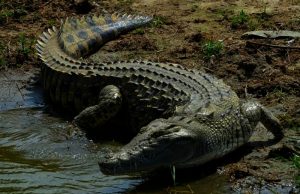
They feature strong conical teeth that efficiently dig into the muscles. They eat fish, mammals, insects, and frogs and are carnivorous. Bull sharks and tiger sharks have been seen to fall victim to them. In the event of an assault, Nile crocodiles have thick armored scaled skin that defends them.
They are one of the most fearless creatures due to their aggressive and secretive temperament. It’s virtually tough to get out of their jaws after they’ve bitten you. Rhinos, Cape Buffaloes, Giraffes, and Elephants have all been attacked and killed by these apex predators.
6. Bears: There are around seven species of bears, most of which are located in Northern temperate climates. They may reach a maximum weight of 1500 pounds depending on the species (over 680 kilos). Bears’ large size means they have few natural adversaries, which is one of the reasons they are such brave creatures. They are incredibly nimble and can move quickly, despite their heavy size. Climbers and swimmers are common among bear species.
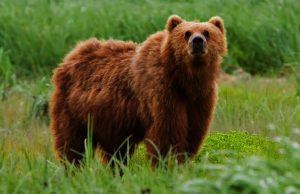
Bears are also quiet creatures who only growl when they’re hungry, fighting for a mate, or feeling threatened by another animal or human. Bears have powerful legs and paws, which they employ to dig out dens and lift big stones and logs weighing hundreds of pounds. The same paws may kill moose or elk in a single strike and drag the carcass far distances. The bear will not be terrified by any animal on the planet.
Recommended: Best Countries to do Business in Africa
7. The ostriches: This large, flightless bird is not to be underestimated, since it can fly quicker than most people can drive their automobiles around town. Male ostriches are exceptionally bold when it comes to guarding their nests, and would hunt down any potential threat before kicking it.
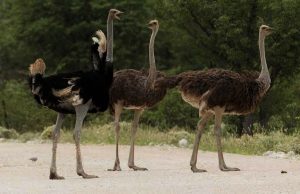
Each of its toes has a long, sharp claw that can rip into flesh like a hot knife through soft butter, causing great damage to everything in its path. Ostriches have been known to battle lions and other predators like hyenas, despite their preference for flight.
8. Lions: Lions’ fearlessness may be exhibited in a variety of scenarios. Fighting numerous predators, guarding the pride’s area against various invaders, and hunting large herbivores like buffalos, giraffes, and even elephants are all part of the job. No animal in the wild is safe when they work together. As a result, their physical bodies have evolved to allow them to reach a height of 2 meters (6.5 feet). A lion’s paw has enough strength to cripple or even kill its opponent. Its roar may be heard for up to 5 miles (8 kilometers), which is enough to scare off intruders.
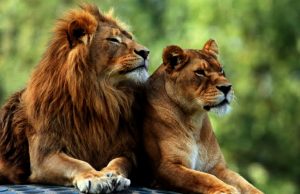
The moniker “King of the Forest” is a bad one for a cat that lives nowhere near the jungle. The lush savannahs of Sub-Saharan Africa are the lion’s principal habitat—at least the “king” part makes sense. Lions are the continent’s undisputed apex predators, and they hunt in packs, sneaking up on and then ambushing antelopes, zebras, warthogs—pretty much anything on four legs that isn’t an elephant, rhino, or hippo, which includes cheetahs, leopards, and hyenas, which lions will kill to eliminate competition. They would rather slumber than do anything else, sleeping up to 20 hours a day and collecting carrion for up to half of their meals.
Recommended: Best science courses to study in the university
9. Rhinoceros: Rhinos come in five different varieties, three of them are found in Africa and two in Asia, and all of them are extremely robust. Rhinos weigh at least 2,000 pounds and occasionally as much as 4,000 pounds, have a thick, nearly armored skin, and a massive horn capable of goring any animal foolish enough to attack.
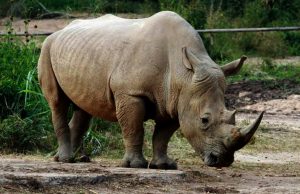
Adult rhinos have no natural predators because of these factors—except, tragically, humans. Rhinos are among the most endangered creatures on the planet, with African species disappearing at an exceptionally rapid rate.
10. Black Mamba: The elapid snake known as the Black Mamba is one of Africa’s most lethal and feared snakes. They may be found in a broad range of environments, including open savannahs, woods, and rocky outcrops. When threatened, they are reputed to be extremely aggressive and will not hesitate to attack with lethal accuracy.
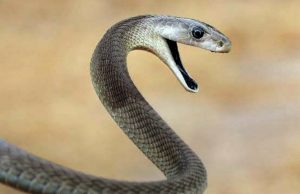
The Black Mamba is named by the color of its lips, which appears to be malevolent. Mambas are quick on the ground and in trees, and their venom is one of the most poisonous on the earth. If you get bitten, you’ll probably pass out within an hour. You only have 15 hours to survive if you don’t have anti-venom to combat the potent neurotoxin.
Recommended: Best Countries to do Business in Africa
11. Tiger: In their natural environments, tigers and lions are the dominant predators. The tiger will undoubtedly challenge the lion in terms of power and ferocity. The biggest members of the cat family, these striped cats may be found in North Korea, China, Eastern Russia, India, and Indonesia. They can survive in a variety of settings because to their high adaptability.
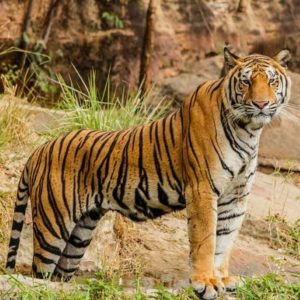
With a tail that is an extra meter (3.3 feet) long, tigers may reach lengths of roughly 2.2 meters (7.2 feet). The biggest of the species, the Siberian tiger, reaches a height of 4 meters (13.1 feet) and may weigh up to 300 kg (660 pounds). The tiger’s paws are strong and can flip large rocks over in addition to packing a lethal blow. Tigers may feed on a variety of species, from the little porcupine to the enormous buffalos, because to their lack of fear.
Also see: Best Freelance Jobs in High Demand in 2023
12. The puff adder: This sluggish-appearing yet fiercely poisonous snake may be found all throughout the African continent and strikes quickly and accurately. Although puff adders don’t aggressively pursue victims, those who do suffer bites frequently step on them or inadvertently approach a well-concealed snake. A puff adder frequently reaches its target when it strikes since it is one of the most venomous snakes in Africa and has a strike pace faster than a camera shutter.
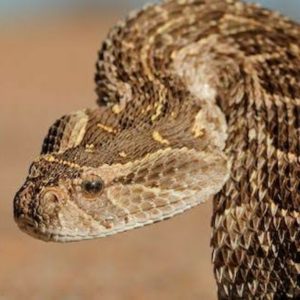
Although they mostly consume rodents, puff adders have been found to eat little duikers (antelope) after first rendering them unconscious with their lethal venom. It’s interesting to note that puff adders are one of the few snake species that are ovoviviparous, which means that the offspring hatch from an egg inside the female’s body.
Recommended: Why Is Sociology a Science? 7 Reasons
Conclusion
Fearlessness in the wild is not often determined by size or nutrition; survival of the fittest is the norm. Depending on its determination to survive, every animal can prove courageous. Size is an advantage in certain animals because it contributes to total strength. Other species’ capacity to protect themselves and their area against predators is unaffected by their nutrition. The elements of skill, strategy, and endurance all play a role.

Edeh Samuel Chukwuemeka, ACMC, is a lawyer and a certified mediator/conciliator in Nigeria. He is also a developer with knowledge in various programming languages. Samuel is determined to leverage his skills in technology, SEO, and legal practice to revolutionize the legal profession worldwide by creating web and mobile applications that simplify legal research. Sam is also passionate about educating and providing valuable information to people.
Thanks, for this explicit exposition.
I am learning.
Hi friend, most of these animals are found in Africa. What about asian bad animals not mentioned here? tiger, gaur, magar, snow leopard.